文章信息
- 吕光辉, 许超, 王辉, 帅红, 王帅, 李佰重, 朱奇宏, 朱捍华, 黄道友
- LÜ Guang-hui, XU Chao, WANG Hui, SHUAI Hong, WANG Shuai, LI Bai-zhong, ZHU Qi-hong, ZHU Han-hua, HUANG Daoyou
- 叶面喷施不同浓度锌对水稻锌镉积累的影响
- Effect of foliar spraying zinc on the accumulation of zinc and cadmium in rice
- 农业环境科学学报, 2018, 37(7): 1521-1528
- Journal of Agro-Environment Science, 2018, 37(7): 1521-1528
- http://dx.doi.org/10.11654/jaes.2018-0709
文章历史
- 收稿日期: 2018-05-30
- 录用日期: 2018-06-07
2. 中国科学院亚热带农业生态研究所, 亚热带农业生态过程重点实验室, 长沙 410125;
3. 湖南农业大学资源环境学院, 长沙 410128
2. Key Laboratory of Subtropical Agro-ecological Processes, Institute of Subtropical Agriculture, Chinese Academy of Sciences, Changsha 410125, China;
3. College of Resources and Environment, Hunan Agricultural University, Changsha 410128, China
矿业活动、工业生产、金属和含金属化合物的农用导致重金属释放到土壤环境中,世界多数国家土壤重金属污染问题突出[1]。镉(Cd)是一种毒性高、移动性大的金属元素,土壤中的Cd易被作物吸收,进入食物链危害人体健康[2]。水稻是世界上最主要的粮食作物之一,也是对Cd吸收能力最强的大宗谷类作物[3],糙米Cd污染问题备受关注。因此,有必要采取高效措施降低稻米Cd含量,减少人体对Cd的摄入。
利用竞争性阳离子与Cd2+的拮抗效应来抑制Cd吸收或转移到作物可食部的农艺调控方法,已逐渐成为Cd污染治理研究的焦点[4-11]。锌(Zn)是植物生长必需的微量元素,由于Zn和Cd两种元素的相似性,使植物对其吸收具有拮抗作用[5, 7, 9, 12-13]。土施和喷施ZnSO4都可降低作物Cd含量,且喷施处理的效果优于土施处理[7, 9, 14-15]。研究表明,喷施Zn肥可通过抑制根部Cd吸收[7, 16]和降低作物体内Cd转运而降低其可食部Cd含量[5, 9, 12, 17-18],但两者所起的作用在不同作物中表现并不一致[5, 7, 18]。
水稻根、第一节和穗轴在Cd吸收和向籽粒转运中起着关键性的作用[19-25],Huang等[22]研究表明,叶面喷施纳米Si显著降低了根到第一节和第一节到穗轴的Cd转运系数,从而降低稻米Cd含量。近年来研究表明,喷施ZnSO4可有效降低水稻稻米Cd含量、提高其Zn含量[14, 17-18, 26],然而其作用机制尚不明确,喷施ZnSO4对水稻吸收转运Cd关键节点影响的研究尚未见报道。为此,本研究采用田间试验,研究叶面喷施不同浓度的ZnSO4对水稻产量、籽粒、穗轴和其他营养器官Cd和Zn含量的影响及籽粒Cd含量与Cd转运系数的关系,确定水稻籽粒降Cd增Zn效果最佳的Zn肥施用量,并探讨其作用机制,以期为稻米Cd污染的农艺防治提供理论依据。
1 材料与方法 1.1 供试材料田间试验选址为湖南省长沙市长沙县北山镇(112°56' 15″ ~113°30' 00″E,27°54'55″N)某Cd污染稻田。北山镇属于亚热带季风气候,气候温和,降雨充沛,当地年平均气温为16~20 ℃,年平均降水量为1200~1500 mm。供试稻田土壤基本理化性质见表 1。
供试水稻品种为株两优189(两系杂交籼稻,湖南希望种业有限公司)。供试ZnSO4为ZnSO4·7H2O,由国药集团化学试剂有限公司生产。
1.2 试验设计设置6个叶面喷施处理:(1)CK,不施Zn;(2)Zn1,1 g·L-1 Zn(ZnSO4);(3)Zn2,2 g·L-1 Zn(ZnSO4);(4)Zn3,3 g·L-1 Zn(ZnSO4);(5)Zn4,4 g·L-1 Zn(ZnSO4);(6)Zn5,5 g·L-1 Zn(ZnSO4)。每个处理5次重复,共30个小区,每个小区面积为6 m2。所有小区随机区组排列,水稻植株间距为20 cm × 20 cm,每小区种植126兜水稻(每兜3株)。每公顷基施复合肥(10-5-10)1200 kg(即基施N 120 kg·hm-2、P2O5 60 kg·hm-2、K2O 120 kg·hm-2),在水稻移栽前1 d施入。水稻的耕作管理与当地农民的耕作管理保持一致。2017年4月19日进行水稻移栽,6月6日和6月9日(灌浆初期)待叶片水干后进行喷施处理,每次叶面喷施水量为1500 L·hm-2(对照喷施等量清水)。2017年7月18日水稻成熟收获时测产。
1.3 样品采集与处理成熟期取水稻植株样品,用自来水洗净后再用去离子水清洗,清洗后的水稻植株分为稻谷、穗轴(包括小穗轴和穗节)、旗叶(包括叶片和叶鞘)、第一节间、第一节、其他叶(除旗叶外的其他叶片和叶鞘)、其他节和节间(除第一节外的其他节和节间)和根,于105 ℃下杀青30 min,70 ℃烘干至恒质量。稻谷烘干后利用脱壳机(JLGJ 4.5,Taizhou Grain Meter Factor,Zhejiang,China)分为糙米和稻壳。水稻各器官样品粉碎后备用。
1.4 植株样品测定植株各器官Cd、Zn含量采用HNO3-HClO4(VHNO3: VHClO4为5:1)消解,滤液用电感耦合等离子光谱发生仪(ICP-OES,720ES)测定。
1.5 数据处理转运系数(TF)(Transfer Factor)是指植物上部某元素的质量分数与植物下部某元素质量分数之比,用来评价植物将重金属从下部向上部运输的能力[27]。用Excel 2010软件进行试验数据的处理及表格制作,SPSS 19.0软件进行统计分析,Tukey' s HSD(Honest Significant Difference)法做多重比较和差异显著性检验,Person法进行相关性分析。
2 结果与分析 2.1 稻谷产量随着叶面喷施Zn浓度的提高稻谷产量呈降低趋势,但各处理间水稻产量无显著差异(P >0.05)(图 1)。
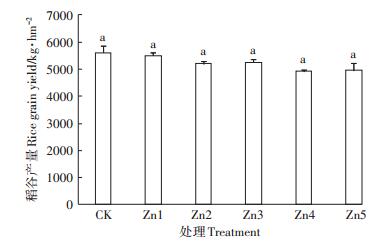
|
| 不同字母表示处理间差异显著(P < 0.05)。下同 Different letters represent significant difference among different treatments(P < 0.05). The same below 图 1 叶面喷施不同浓度Zn对水稻产量的影响 Figure 1 Effect of foliar application different concentrations of zinc on rice yield |
水稻不同器官Cd含量表现为根>第一节>旗叶>其他叶>其他节和节间>穗轴>稻壳>第一节间>糙米(图 2)。随着喷Zn浓度的增加,各器官Cd含量呈现先降低后增加的变化趋势。与CK处理相比,叶面喷Zn使糙米、稻壳、穗轴、第一节间、第一节、旗叶、其他叶、其他节和节间、根Cd含量分别降低9.0%~47.8%、10.7%~27.5%、3.7%~29.4%、5.5%~47.0%、9.5%~ 53.6%、7.6%~44.1%、5.7%~45.4%、16.1%~62.7%和4.2%~18.9%,表明叶面喷施1~5 g·L-1 ZnSO4可在一定程度上降低水稻各器官Cd含量,其中喷施4 g·L-1 ZnSO4糙米Cd含量降低最大,达47.8%。糙米Cd与稻壳Cd、穗轴Cd、旗叶Cd、第一节间Cd、第一节Cd、其他叶Cd、其他节和节间Cd、根Cd均呈显著正相关关系(P < 0.01),相关系数分别为0.653、0.856、0.878、0.857、0.853、0.876、0.861和0.745(图 3)。
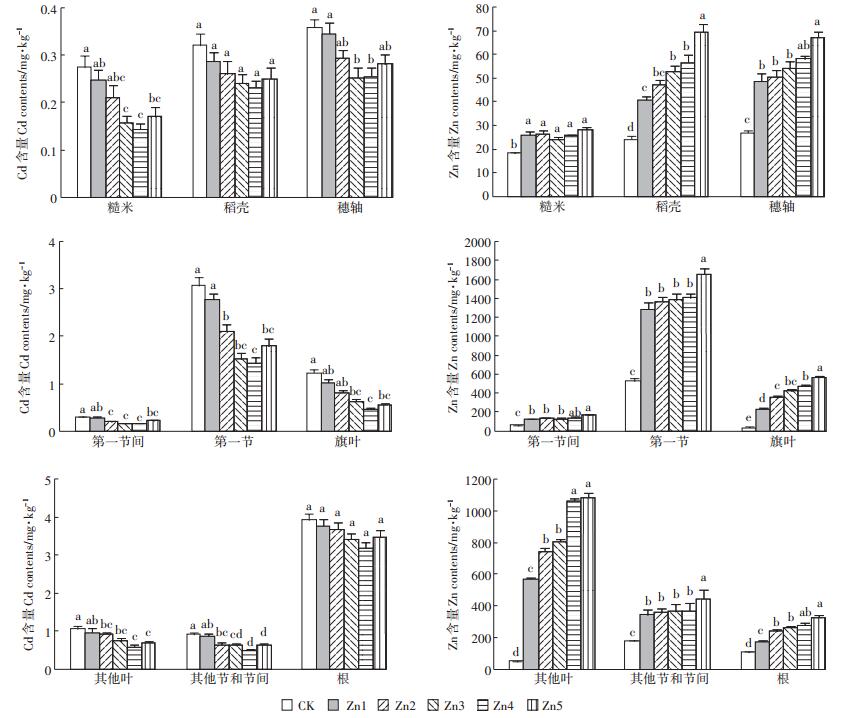
|
| 图 2 喷施不同浓度Zn对水稻植株Cd和Zn含量的影响 Figure 2 Effect of foliar application of different concentrations of zinc on cadmium and zinc concentrations in rice plants |
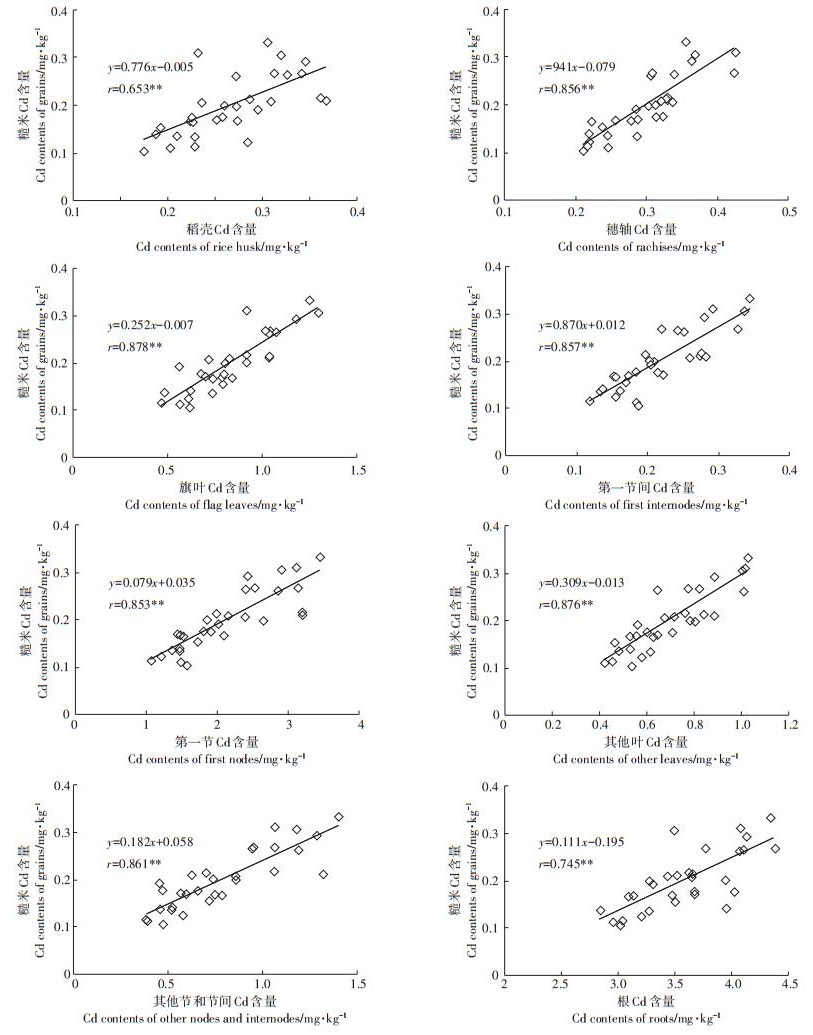
|
| **表示在P < 0.01水平极显著相关。下同 **indicates extremely significant correlation at P < 0.01. The same below 图 3 糙米Cd与其他器官Cd含量的关系 Figure 3 Relationship between brown rice Cd and Cd in other organs |
水稻不同器官Zn含量表现为:第一节>其他叶>旗叶>其他节和节间>根>第一节间>穗轴>稻壳>糙米(图 2)。随着喷Zn浓度的增加,水稻各器官Zn含量呈逐渐升高的变化趋势。与CK处理相比,叶面喷Zn使糙米、稻壳、穗轴、第一节间、第一节、旗叶、其他叶、其他节和节间、根Zn含量分别显著提高31.7%~55.6%、68.3%~188.0%、81.7%~150.8%、100.7%~172.7%、144.7%~ 214.7%、588.6%~1 571.3%、1 035.7%~2 068.4%、92.6%~ 149.8%和63.1%~205.5%(P < 0.05),表明叶面喷施1~ 5 g·L-1 ZnSO4显著提高水稻各器官Zn含量。
2.4 Cd转运系数旗叶到第一节Cd转运系数(TF第一节/旗叶)>穗轴到糙米Cd转运系数(TF糙米/穗轴)>根到第一节Cd转运系数(TF第一节/根)>第一节到穗轴Cd转运系数(TF穗轴/第一节)(图 4)。叶面喷Zn处理TF第一节/旗叶降低1.0%~30.3%、TF第一节/根降低5.8%~43.7%、TF糙米/穗轴降低4.7%~ 26.7%、而TF穗轴/第一节提高5.0%~47.1%。叶面喷Zn降低了Cd从旗叶和根向第一节及穗轴向糙米的转运、促进了Cd从第一节向穗轴的转运,喷施3~5 g·L-1 ZnSO4时尤为明显。
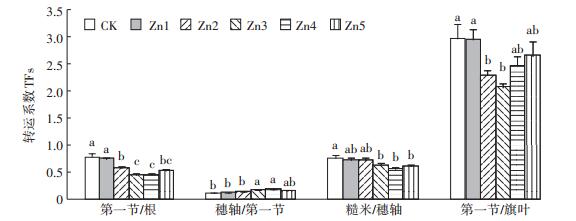
|
| 图 4 喷施不同浓度Zn对水稻Cd转运系数的影响 Figure 4 Effect of foliar application of different concentrations of zinc on the translocation factors of cadmium in rice |
糙米Cd含量与第一节/根和糙米/穗轴Cd转移系数显著正相关,与穗轴/第一节Cd转运系数显著负相关(图 5)。
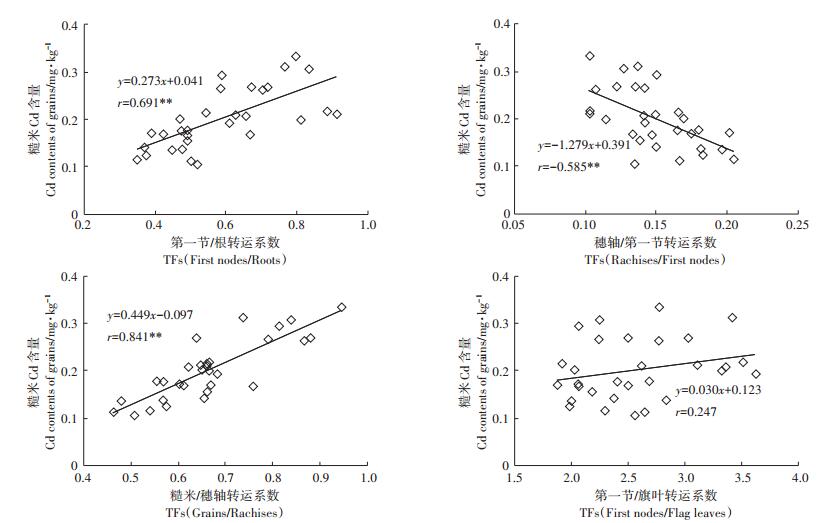
|
| 图 5 糙米Cd含量与水稻Cd转运系数的关系 Figure 5 Relationship between cadmium concentrations in brown rice and translocation factors of cadmium in rice |
本研究结果表明,Cd污染土壤上叶面喷施不同浓度的ZnSO4对水稻产量无显著影响,这与前人的研究结果类似[9, 16, 18],这可能是由于供试土壤有效Zn含量较高,不属于缺Zn土壤,不能通过提高作物Zn营养来促进作物生长。
叶面喷施1~5 g·L-1 ZnSO4显著提高水稻各器官Zn含量,且随着喷Zn浓度的提高各器官Zn含量逐渐上升(图 2)。这可能是由于叶片中的Zn能够通过韧皮部运到其他器官进行再分配[28-29],随着喷Zn浓度的增加,叶片对Zn的吸收量增加,其他器官的Zn含量会增加;喷施过程中有雾滴落入土壤中导致根部土壤Zn含量及有效性增加,植株对Zn的吸收量增加,Zn由根到地上部的转运增加,进而水稻各个器官的Zn含量增加[30];喷施Zn增加了叶片上Zn的附着吸附量。与对照相比,叶面喷Zn糙米Zn含量提高31.7%~55.6%(图 2),因此,叶面喷Zn是生物强化稻谷Zn含量的一种有效措施。
叶面喷施1~5 g·L-1 ZnSO4在一定程度上降低水稻各器官Cd含量,叶面喷施Zn后水稻器官中Cd浓度的降低部分归因于水稻器官中Zn浓度的显著增加,水稻各器官(稻壳除外)Cd与Zn含量之间显著负相关(糙米、穗轴、第一节间、第一节、旗叶、其他叶、其他节和节间、根中Cd与Zn之间相关系数分别为-0.435*、-0.375*、-0.456*、-0.654**、-0.651**、-0.701**、-0.741**和-0.430*);水稻各器官中Cd与Zn之间表现为拮抗作用。有研究结果表明喷Zn能降低作物Cd含量、Cd与Zn之间表现为拮抗效应[7, 12, 31-33]。Zn、Cd之间的拮抗作用会抑制根系对镉的吸收及Cd从根到地上部的转运[26]:一方面Zn与Cd竞争水稻细胞膜表面的吸收位点,Zn吸收量增加,Cd吸收量减少[31];另一方面Zn与Cd在植物体运输中可以利用相同的转运蛋白,当植物体内Zn含量增加时就会与Cd竞争这些转运蛋白上的重金属结合位点,最终导致植物体内的Cd含量减少[7]。水稻用同一转运蛋白吸收和转运Cd和Zn,如转运蛋白OsZNT1[33]和金属ATPase 2(OsHMA2)转运蛋白[34-35]。本研究结果表明,糙米Cd含量与根Cd含量、第一节/根和糙米/穗轴Cd转移系数显著正相关,与穗轴/第一节Cd转运系数显著负相关,表明叶面喷Zn降低糙米Cd含量主要是由于降低根Cd吸收和根与旗叶向第一节及穗轴向糙米Cd的转运引起的。代晶晶等[16]研究同样表明喷施Zn肥主要是通过减少根部Cd吸收和向地上部Cd转运来降低油菜华俊地上部Cd含量。然而,叶面喷施Zn调控水稻Cd吸收与转运的分子机制需要进一步探讨。
4 结论(1)喷施1~5 g·L-1 ZnSO4对水稻产量无显著影响。
(2)喷施3~5 g · L-1 ZnSO4显著降低糙米Cd含量,同时显著提高稻米Zn含量,是叶面调控稻米Cd含量积累的适宜用量。
(3)叶面喷Zn降低糙米Cd含量主要是由于根Cd吸收和降低根和旗叶向第一节及穗轴向糙米的转运引起的。
| [1] |
Mahar A, Wang P, Ali A, et al. Challenges and opportunities in the phytoremediation of heavy metals contaminated soils:A review[J]. Ecotoxicology and Environmental Safety, 2016, 126: 111-121. DOI:10.1016/j.ecoenv.2015.12.023 |
| [2] |
Satarug S, Baker J R, Urbenjapol S, et al. A global perspective on cadmium pollution and toxicity in non-occupationally exposed population[J]. Toxicology Letters, 2003, 137(1/2): 65-83. |
| [3] |
Chaney R L, Reeves P G, Ryan J A, et al. An improved understanding of soil Cd risk to humans and low cost methods to phytoextract Cd from contaminated soils to prevent soil Cd risks[J]. Biometals, 2004, 17(5): 549-553. DOI:10.1023/B:BIOM.0000045737.85738.cf |
| [4] |
吕选忠, 宫象雷, 唐勇. 叶面喷施锌或硒对生菜吸收镉的拮抗作用研究[J]. 土壤学报, 2006, 43(5): 868-870. LÜ Xiang-lei, GONG Xiang-lei, TANG Yong. Antagonistic effect of foliar application Se or Zn on absorption of Cd in lettuce[J]. Acta Pedologica Sinica, 2006, 43(5): 868-870. |
| [5] |
陈贵青, 张晓璟, 徐卫红, 等. 不同Zn水平下辣椒体内Cd的积累、化学形态及生理特性[J]. 环境科学, 2010, 31(7): 1657-1662. CHEN Gui-qing, ZHANG Xiao-jing, XU Wei-hong, et al. Effect of different zinc levels on accumulation and chemical forms of cadmium, and physiological characterization in Capsicum annuum L.[J]. Environmental Science, 2010, 31(7): 1657-1662. |
| [6] |
刘俊, 周坤, 徐卫红, 等. 外源铁对不同番茄品种生理特性、镉积累及化学形态的影响[J]. 环境科学, 2013, 34(10): 4126-4131. LIU Jun, ZHOU Kun, XU Wei-hong, et al. Effect of exogenous zinc on activity of antioxidant enzyme, accumulation and chemical forms of cadmium in different varieties of tomato[J]. Environmental Science, 2013, 34(10): 4126-4131. |
| [7] |
董如茵, 徐应明, 王林, 等. 土施和喷施锌肥对镉低积累油菜吸收镉的影响[J]. 环境科学学报, 2015, 35(8): 2589-2596. DONG Ru-yin, XU Ying-ming, WANG Lin, et al. Effects of soil application and foliar spray of zinc fertilizer on cadmium uptake in a pakchoi cultivar with low cadmium accumulation[J]. Acta Scientiae Circumstantiae, 2015, 35(8): 2589-2596. |
| [8] |
杨芸, 周坤, 徐卫红, 等. 外源铁对不同品种番茄光合特性、品质及镉积累的影响[J]. 植物营养与肥料学报, 2015, 21(4): 1006-1015. YANG Yun, ZHOU Kun, XU Wei-hong, et al. Effect of exogenous iron on photosynthesis, quality, and accumulation of cadmium in different varieties of tomato[J]. Journal of Plant Nutrition and Fertilizer, 2015, 21(4): 1006-1015. DOI:10.11674/zwyf.2015.0420 |
| [9] |
Sarwar N, Ishaq W, Farid G, et al. Zinc-cadmium interactions:Impact on wheat physiology and mineral acquisition[J]. Ecotoxicology & Environmental Safety, 2015, 122(528): 528-536. |
| [10] |
Qaswar M, Hussain S, Rengel Z. Zinc fertilization increases grain zinc and reduces grain lead and cadmium concentrations more in zinc-biofortied than standard wheat cultivar[J]. Science of the Total Environment, 2017, 605/606: 454-460. DOI:10.1016/j.scitotenv.2017.06.242 |
| [11] |
Rizwan M, Ali S, Hussain A, et al. Effect of zinc-lysine on growth, yield and cadmium uptake in wheat(Triticum aestivum L.)and health risk assessment[J]. Chemosphere, 2017, 187: 35-42. DOI:10.1016/j.chemosphere.2017.08.071 |
| [12] |
周坤, 刘俊, 徐卫红, 等. 外源锌对不同番茄品种抗氧化酶活性、镉积累及化学形态的影响[J]. 环境科学学报, 2014, 34(6): 1592-1599. ZHOU Kun, LIU Jun, XU Wei-hong, et al. Effect of exogenous zinc on activity of antioxidant enzyme, accumulation and chemical forms of cadmium in different varieties of tomato[J]. Acta Scientiae Circumstantiae, 2014, 34(6): 1592-1599. |
| [13] |
辜娇峰, 杨文弢, 周航, 等. 外源锌刺激下水稻对土壤镉的累积效应[J]. 环境科学, 2016, 37(9): 3554-3561. GU Jiao-feng, YANG Wen-tao, ZHOU Hang, et al. Provoking effects of exogenous Zn on cadmium accumulation in rice[J]. Environmental Science, 2016, 37(9): 3554-3561. |
| [14] |
罗婷. 镁、锌和石灰等物质抑制土壤镉有效性及水稻吸收镉的研究[D]. 雅安: 四川农业大学, 2013. LUO Ting. Availability of soil cadmium and its uptake by rice as restrained by using magnesium, zinc, lime and their combinations[D]. Ya'an: Sichuan Agricultural University, 2013. |
| [15] |
Saifullah, Sarwar N, Bibi S, et al. Effectiveness of zinc application to minize cadmium toxicity and accumulation in wheat(Triticum aestivum L.)[J]. Environmental Earth Science, 2014, 71(4): 1663-1672. DOI:10.1007/s12665-013-2570-1 |
| [16] |
代晶晶, 徐应明, 王林, 等. 不同锌营养下喷施锌肥对油菜生长和元素含量的影响[J]. 环境化学, 2017, 36(5): 1017-1025. DAI Jing-jing, XU Ying-ming, WANG Lin, et al. Effect of foliar zinc application on growth and element concentrations of pakchoi under different zinc nutrition status[J]. Environmental Chemistry, 2017, 36(5): 1017-1025. DOI:10.7524/j.issn.0254-6108.2017.05.2016101201 |
| [17] |
龙思斯, 杨益新, 宋正国, 等. 三种类型阻控剂对不同品种水稻富集镉的影响[J]. 农业资源与环境学报, 2016, 33(5): 459-465. LONG Si-si, YANG Yi-xin, SONG Zheng-guo, et al. Effects of three inhibitors on the accumulation of cadmium in rice(Oryza sativa L.)[J]. Journal of Agricultural Resources and Environment, 2016, 33(5): 459-465. |
| [18] |
靳磊, 胡召华, 纪雄辉, 等. 不同时期喷施Zn肥抑制水稻Cd吸收转运的效果[J]. 湖南农业科学, 2017(8): 37-40. JIN Lei, HU Zhao-hua, JI Xiong-hui, et al. Effects of zinc foliar application at different growth stages on cadmium absorption and transport in rice[J]. Hunan Agricultural Sciences, 2017(8): 37-40. |
| [19] |
Uraguchi S, Mori S, Kuramata M, et al. Root-to-shoot Cd translocation via the xylem is the major process determining shoot and grain cadmium accumulation in rice[J]. Journal of Experimental Botany, 2009, 60(9): 2677-2688. DOI:10.1093/jxb/erp119 |
| [20] |
Rodda M S, Li G, Reid R J. The timing of grain Cd accumulation in rice plants:The relative importance of remobilization with the plant and root uptake post-flowering[J]. Plant and Soil, 2011, 347(1/2): 105-114. |
| [21] |
Yamaguchi N, Ishikawa S, Abe T, et al. Role of the node in controlling traffic of cadmium, zinc, and manganese in rice[J]. Journal of Experimental Botany, 2012, 63(7): 2729-2737. DOI:10.1093/jxb/err455 |
| [22] |
Huang G X, Ding C F, Guo F Y, et al. The role of node restriction on cadmium accumulation in the brown rice of 12 Chinese rice(Oryza sativa L.) cultivars[J]. Journal of Agricultural and Food Chemistry, 2017, 65: 10157-10164. DOI:10.1021/acs.jafc.7b03333 |
| [23] |
Chen R, Zhang C B, Zhao Y L, et al. Foliar application with nano-silicon reduced cadmium accumulation in grains by inhibiting cadmium translocation in rice plants[J]. Environmental Science & Pollution Research, 2017, 25(3): 2361-2368. |
| [24] |
居学海, 张长波, 宋正国, 等. 水稻籽粒发育过程中各器官镉积累量的变化及其与基因型和土壤镉水平的关系[J]. 植物生理学报, 2014, 50(5): 634-640. JU Xue-hai, ZHANG Chang-bo, SONG Zheng-guo, et al. Changes in cadmium accumulation in rice organs during grain development and their relationship with genotype and cadmium levels in soil[J]. Plant Physiology Journal, 2014, 50(5): 634-640. |
| [25] |
文志琦, 赵艳玲, 崔冠男, 等. 水稻营养器官镉积累特性对稻米镉含量的影响[J]. 植物生理学报, 2015, 51(8): 1280-1286. WEN Zhi-qi, ZHAO Yan-ling, CUI Guan-nan, et al. Effects of cadmium accumulation characteristics in vegetative organs on cadmium content in grains of rice[J]. Plant Physiology Journal, 2015, 51(8): 1280-1286. |
| [26] |
Fahad S, Hussain S, Khan F, et al. Effects of tire rubber ash and zinc sulfate on crop productivity and cadmium accumulation in five rice cultivars under field conditions[J]. Environmental Science and Pollution Research, 2015, 22(16): 12424-12434. DOI:10.1007/s11356-015-4518-3 |
| [27] |
陈喆, 铁柏清, 雷鸣, 等. 施硅方式对稻米镉阻隔潜力研究[J]. 环境科学, 2014, 35(7): 2762-2770. CHEN Zhe, TIE Bo-qing, LEI Ming, et al. Phytoexclusion potential studies of Si fertilization modes on rice cadmium[J]. Environmental Science, 2014, 35(7): 2762-2770. |
| [28] |
Pearson J N, Rengel Z. Distribution and remobilization of Zn and Mn during grain development in wheat[J]. Journal of Experimental Botany, 1994, 45(281): 1829-1835. |
| [29] |
Haslett B S, Reid R J, Rengel Z. Zinc mobility in wheat:Uptake and distribution of zinc applied to leaves or roots[J]. Annals of Botany, 2001, 87(3): 379-386. DOI:10.1006/anbo.2000.1349 |
| [30] |
索炎炎, 吴士文, 朱骏杰, 等. 叶面喷施锌肥对不同镉水平下水稻产量及元素含量的影响[J]. 浙江大学学报(农业与生命科学版), 2012, 38(4): 449-458. SUO Yan-yan, WU Shi-wen, ZHU Jun-jie, et al. Effects of foliar Zn application on rice yield and element contents under different Cd levels[J]. Journal of Zhejiang University(Agriculture & Life Sciences), 2012, 38(4): 449-458. DOI:10.3785/j.issn.1008-9209.2012.04.013 |
| [31] |
Hart J J, Welch R M, Norvell W A, et al. Transport interactions between cadmium and zinc in roots of bread and durum wheat seedlings[J]. Physiologia Plantarum, 2002, 116(1): 73-78. DOI:10.1034/j.1399-3054.2002.1160109.x |
| [32] |
Saifullah, Javed H, Naeem A, et al. Timing of foliar Zn application plays a vital role in miniming Cd accumulation in wheat[J]. Environmental Science and Pollution Research, 2016, 23(16): 16432-16439. DOI:10.1007/s11356-016-6822-y |
| [33] |
Ramesh S A, Shin R, Eide D J, et al. Differential metal selectivity and gene expression of two zinc transporters from rice[J]. Plant Physiology, 2003, 133(1): 126-134. DOI:10.1104/pp.103.026815 |
| [34] |
Satoh-Nagasawa N, Mori M, Nakazawa N, et al. Mutations in rice(Oryza sativa)heavy metal ATPase 2(OsHMA2)restrict the translocation of zinc and cadmium[J]. Plant & Cell Physiology, 2012, 53(1): 213-224. |
| [35] |
Takahashi R, Ishimaru Y, Shimo H, et al. The OsHMA2 transporter is involved in root-to-shoot translocation of Zn and Cd in rice[J]. Plant, Cell & Environment, 2012, 35(11): 1948-1957. |
 2018, Vol. 37
2018, Vol. 37





